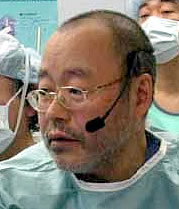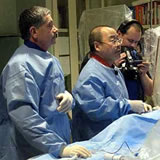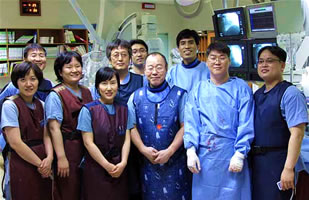 |

|
 |

As
part of its ongoing interview series on the transradial approach,
Angioplasty.Org recently talked with Dr. Shigeru Saito, Director
of Cardiology and Catheterization Laboratories, Shonan
Kamakura General Hospital, Kamakura, Japan. Dr. Saito
is one of the leading supporters and practitioners of transradial
coronary intervention (TRI) in the world. As an evangelist
for TRI, he has traveled the world to teach and demonstrate
the benefits and techniques of this alternative to the femoral
approach.
One of Dr. Saito’s primary activities is to develop a
strategy of retrograde approach in coronary angioplasty
for chronic total occlusion. He serves as President of
NPO International TRI Network. He serves on the editorial
boards of Catheterization and Cardiovascular Interventions, Journal
of Invasive Cardiology and the International Journal
of Cardiology. Dr. Saito is widely published in the
fields of acute myocardial infarction, cardiomyopathy,
coronary angioplasty and the transradial approach.
For more about the transradial approach, visit our Radial
Access Center.
|
|

Dr. Shigeru
Saito teaching
during a live demonstration course |
Q: How did you first learn about the radial technique
for angioplasty?
Dr. Saito: Over the past twenty years, I have travelled a lot to
foreign countries to do angioplasty, PTCA, and it was in 1995 that
I visited Taiwan to do angioplasty. And there I met Dr. Chiung-Jen
Wu from Kaohsiung and he was doing the transradial approach.
I was very surprised because I knew the transradial approach, but
I supposed that it was possible only for Western people, because
their body size is big. So when I saw that it was possible, feasible,
even for these Chinese patients, after coming back to Japan, I declared
that from then on I would completely switch to the transradial approach.
Q: At that time, when you started, what was the percentage of cases
in Japan that were done transradially?
Dr. Saito: Zero! No one. I was the first to do transradial approach
in Japan.
Q: Why did you switch to the radial
approach? Cardiologists we’ve
interviewed often say they did because the radial approach has fewer
complications.
Dr. Saito: Why switch? Because it was something new. And I always
want to try something new! So that’s the reason. In those days
nobody knew that the transradial approach had a lower complication
rate. It’s true, but it was not proven in the Japanese patient
population. So my strategy was completely switched to the transradial
approach and my role was to show if that approach was good or not
in the Japanese patient population.
Q: That was a decade ago. What
percentage of cases is being done radially in Japan now?
Dr. Saito: I think, among angioplasty procedures, maybe 50%.

Drs.
Coppola and Saito during
transradial case
at
St. Vincent's in NYC |
|
Q: That’s quite
a change. In the U.S. it’s only in the single digits, except
in specific hospitals where radial is practiced -- in those
it’s
more like 50%. Can you make any suggestions for physicians
who
want
to learn the
transradial
approach?
Dr. Saito: I think the most important
thing is you have to totally switch to the radial approach. It’s very important.
Some physicians want to do transradial approach in a very small
number of patients. For example, if the femoral access failed – some
physicians want to take the radial approach only for those cases.
But it’s not good. In my hospital, we always take the radial
approach, so from the beginning young physicians are getting
familiar with transradial approach.
Any physician can visit hospitals,
like St. Vincent’s, and they can learn. Also right now we have
a very good simulator and all young physicians can try it. It’s
fast. |
Q: In your opinion, what is the learning curve for radial? How many
cases before one can be comfortable with it?
Dr. Saito. I think 50 cases. But after we cross that learning curve
we can do anything from the radial approach.
Q: For example, do you ever use
Rotablators?
Dr. Saito: Yes, and also the Directional Coronary Atherectomy (DCA)
device. It needs an 8F guiding catheter, but I published several
years ago on the radial artery size in the Japanese patient population.
And we found that for Japanese male patients, about 40% can accept
8F in radial.
Q: Is there anything you cannot do
from the radial approach? You are one of the experts in opening
chronic
total occlusions (CTO) – do
you use radial in those?
Dr. Saito: For example, today I did the femoral approach in some
cases because I could not feel any radial pulse. Also another situation
is if the patient has chronic hemodialysis for renal failure. In
that case we have to preserve the radial shunt, so in those cases
I never touch the radial.
The only problem for CTO angioplasty from the radial
approach is that sometimes we need a bilateral injection. For example,
if the
occlusion is in the LAD, sometimes we need a right coronary injection.
That means we need two catheters simultaneously. And from the radial
artery approach, because the artery is smaller, we cannot do two
catheters simultaneously. But from the groin, because the size of
the artery is big, sometimes we can take two punctures from the same
side [or one from each approach].
Q: In one
of today's cases, you did simultaneous injections, using
one from the
femoral
and one from the radial.
Which brings me to a question: have some of your
patients experienced both the femoral and radial approaches,
and what
are
their opinions?
Dr. Saito: Of course, the patient’s preference is from the
wrist, because the patient can get up immediately and even can go
home immediately.
Q: Do you find that patients come to you or to your hospital specifically
because you offer transradial?
Dr. Saito: Yes, yes. Of course. Because we are very famous for doing
the transradial approach. But that’s a problem, now. The transradial
approach is getting very popular in Japan, so I have no advantage
anymore (laughs).
Q: I see. So you’ve taught yourself
out of a position....
Dr. Saito: Yes!
Q: What do you think needs
to happen in the U.S. for transradial to spread?
Dr. Saito:
What happened in Japan when we started the transradial approach,
in
the initial phase, we had a lot of trouble, skepticism from
some physicians.
They
are a little bit older, you know, and they never wanted to
start the transradial approach, because they are only familiar
with
the femoral approach. And I think the same thing will happen
in any country -- also in the United States, even in New York
City.
So the most important thing is that we have to create
some kind of community of radial physicians. It’s very important.
The physicians must have some kind of periodical or meeting,
small meeting or big,
perhaps during the SCAI or something like that. And there has
to be a mutual exchange of opinions. |
|

Dr. Saito
with catheterization
laboratory team |
Q: Why do you feel the radial approach is important in PCI (Percutaneous
Coronary Interventions) today, especially when anticoagulant therapies
are used extensively?
Dr. Saito: From the femoral groin, the first thing is that the artery
size is huge, very big, and near the artery we have a very important
nerve. So if we have something like a hematoma or bleeding here,
we have a lot of complications from the groin. But from radial, behind
the artery there is a bone, and in front of the artery there is skin.
So that means no space around the artery from the wrist, so the chance
of causing bleeding is very low. Also, along the radial artery there
is no nerve.
Q: In the U.S., a lot of physicians use vascular closure devices
to help stop bleeding in the femoral artery.
Dr. Saito: Any comparative data shows that the best way from the
femoral groin approach is compression, manual compression. And any
hemostasis device has a higher incidence of complication.
Q: How do you achieve hemostasis in the radial approach?
Dr. Saito: We have some kind of band. We don’t need anything;
just hold the band here and the patient can move and walk immediately.
Q: With the growth of radial access,
are you now doing outpatient angioplasty?
Dr. Saito: We call it one-day admission. No overnight.

Shigeru
Saito, MD |
|
Q: Thank you
Dr. Saito. We look forward to watching you perform cases
during Dr.
Coppola and
Kwan’s upcoming course at St. Vincent’s Hospital in New York.
Dr.
Saito: You are welcome.
NOTE: Dr. Saito will be on the guest
faculty for an
upcoming course on the transradial approach at
St. Vincent's Hospital in New York City being held on June
12-13,
2008. The course is fully enrolled, but future courses will be
announced in Angioplasty.Org's Radial
Access Center. |
This interview was conducted
in April 2008 by Burt Cohen of Angioplasty.Org.
|





